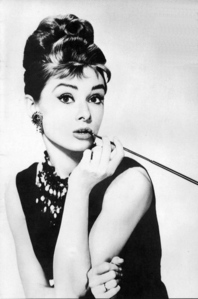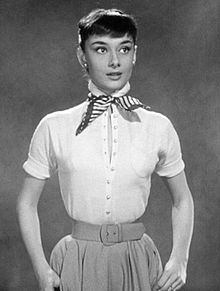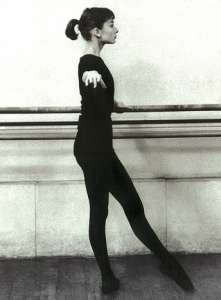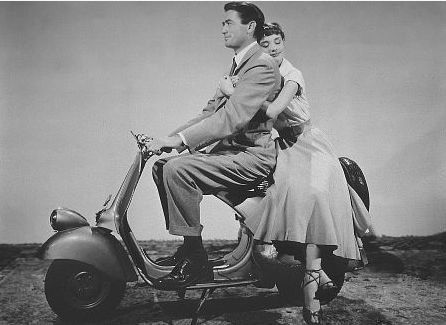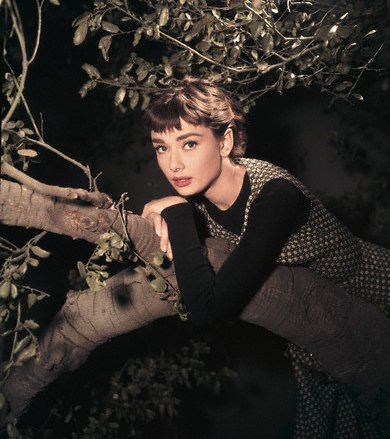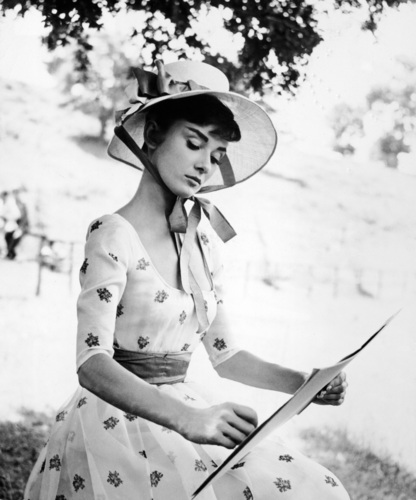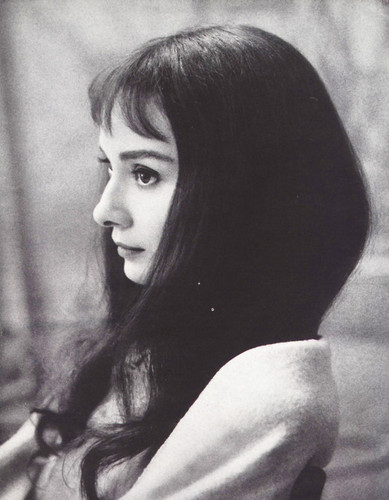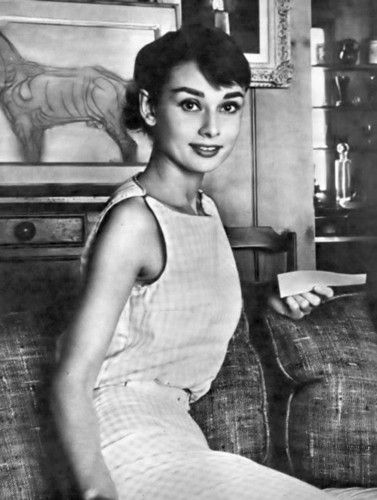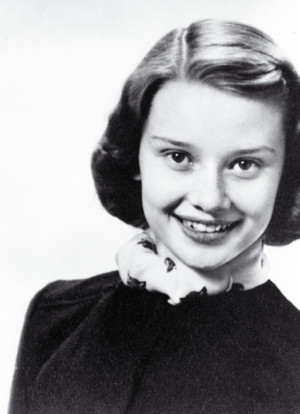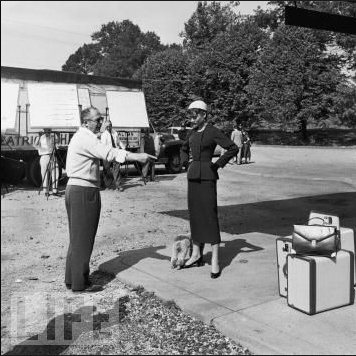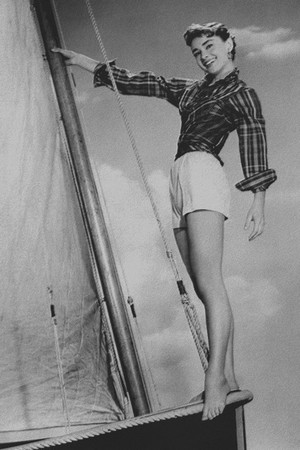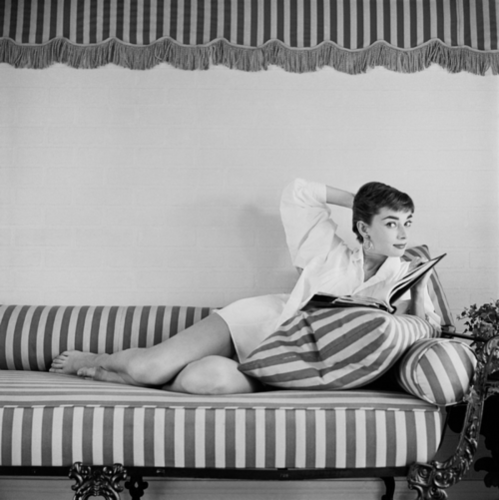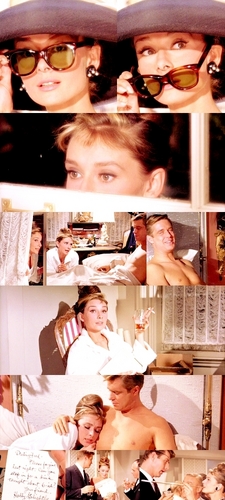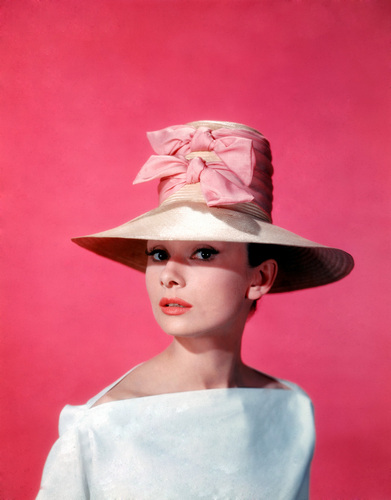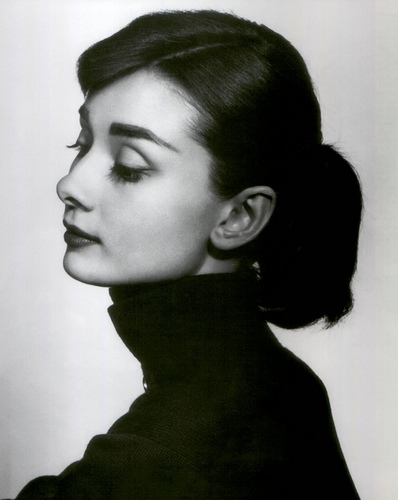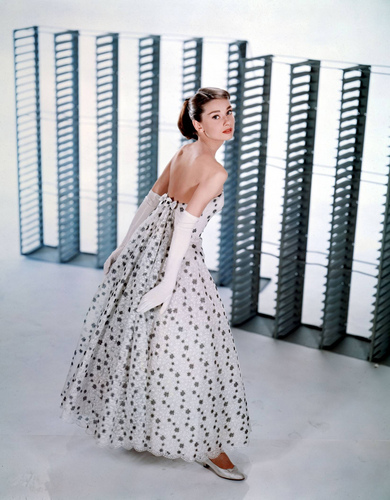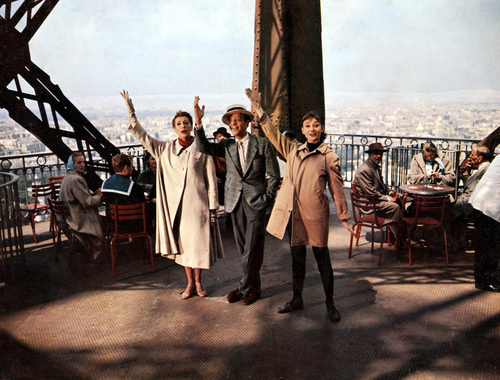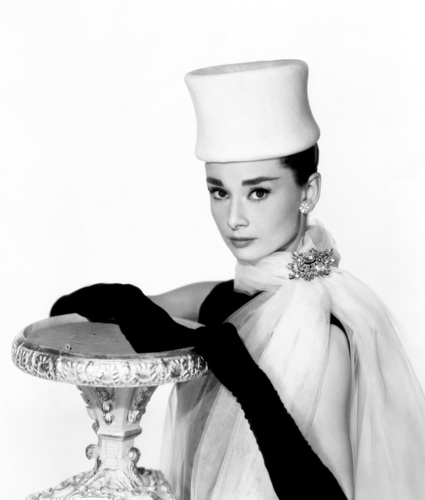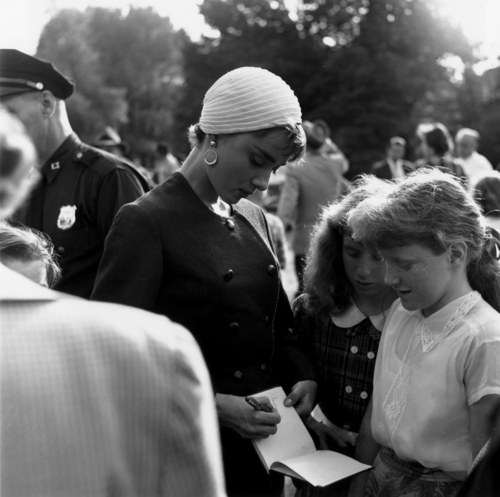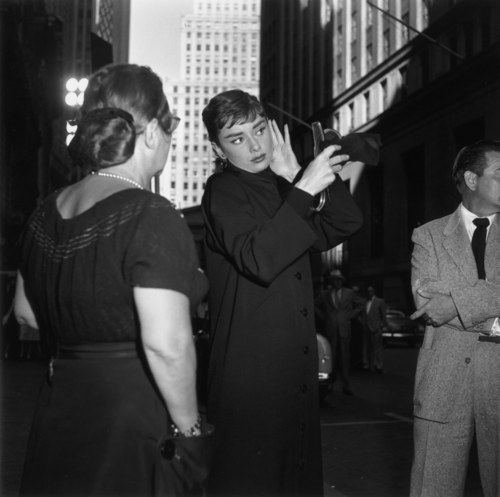The Beginning:
Audrey Kathleen Ruston (changed to Hepburn)was born on the 4 May 1929 in Ixelles, Belgium to Joseph Victor Anthony Ruston and his second wife Ella Van Heemstra, who was the the former Baroness Ella (1900-1984), a Dutch aristocrat. Although born in Belgium, Hepburn had British citizenship and attended school in England as a child. In 1935, Hepburn's parents divorced and her father, a Nazi sympathiser, left the family.
Hepburn later referred to her father leaving as 'the most traumatic moment of her life.'
In 1939, her mother moved her and her two half-brothers to their grandfather's home in Arnhem in the Netherlands, believing the Netherlands would be safe from German attack. Hepburn attended the Arnhem Conservatory from 1939 to 1945, where she trained in ballet along with the standard school curriculum. In 1940, the Germans invaded the Netherlands. During the German occupation, Hepburn adopted the pseudonym Edda van Heemstra, modifying her mother's documents because an 'English sounding' name was considered dangerous, with her mother feeling that "Audrey" might indicate her British roots too strongly. Being English in the occupied Netherlands was not an asset; it could have attracted the attention of the occupying German forces and resulted in confinement or even deportation. Edda was never her legal name, also it was a version of her mother's name Ella. By 1944, Hepburn had become a proficient ballerina.
Early Career:
In 1945, after the war, Hepburn left the Arnhem Conservatory and moved to Amsterdam, where she took ballet lessons with Sonia Gaskell. Hepburn appeared as a stewardess in a short tourism film for KLM, before travelling with her mother to London. Gaskell provided an introduction to Marie Rambert, and Hepburn studied ballet at the "Ballet Rambert", supporting herself with part time work as a model. Hepburn eventually asked Rambert about her future. Rambert assured her that she could continue to work there and have a great career, but the fact she was relatively tall (1.7m/5 ft 7) coupled with her poor nutrition during the war would keep her from becoming a prima ballerina. Hepburn trusted Rambert's assessment and decided to pursue acting, a career in which she at least had a chance to excel. After Hepburn became a star, Rambert said in an interview, "She was a wonderful learner. If she had wanted to persevere, she might have become an outstanding ballerina".
Hepburn's mother worked menial jobs in order to support them, and Hepburn needed to find employment. Since she trained to be a performer all her life, acting seemed a sensible career. She said, "I needed the money; it paid ₤3 more than ballet jobs". Her acting career began with the educational film Dutch in Seven Lessons (1948). She played in musical theatre in productions such as High Button Shoes and Sauce Piquante in the West End. Her theatre work revealed that her voice was not strong and needed to be developed, and during this time she took elocution lessons with the actor Sir Felix Aylmer. Part time modelling work was not always available and Hepburn registered with the casting officers of Britain's film studios in the hope of getting work as an extra.
Hepburn's first role in a motion picture was in the British film One Wild Oat in which she played a hotel receptionist. She played several more minor roles in Young Wives' Tale, Laughter in Paradise, The Lavender Hill Mob, and Monte Carlo Baby.
During the filming of Monte Carlo Baby Hepburn was chosen to play the lead character in the Broadway play Gigi, that opened on 24 November, 1951, at the Fulton Theatre and ran for 219 performances. The writer Colette, when she first saw Hepburn, reportedly said "Voilà! There's our Gigi!" She won a Theatre World Award for her performance. Hepburn's first significant film performance was in the Thorold Dickinson film Secret People (1952), in which she played a prodigious ballerina. Hepburn did all of her own dancing scenes.
Major Role:
Her first starring role was with Gregory Peck in the Italian-set Roman Holiday (1953). Producers initially wanted Elizabeth Taylor for the role, but director William Wyler was so impressed by Hepburn's screen test (the camera was left on and candid footage of Hepburn relaxing and answering questions, unaware that she was still being filmed, displayed her talents), that he cast her in the lead. Wyler said, "She had everything I was looking for: charm, innocence and talent. She also was very funny. She was absolutely enchanting, and we said, 'That's the girl!'"
Hepburn's performance received much critical praise. A. H. Weiler noted in The New York Times, "Although she is not precisely a newcomer to films, Audrey Hepburn, the British actress who is being starred for the first time as Princess Ann, is a slender, elfin, and wistful beauty, alternately regal and childlike in her profound appreciation of newly found, simple pleasures and love. Although she bravely smiles her acknowledgment of the end of that affair, she remains a pitifully lonely figure facing a stuffy future". After filming Roman Holiday for four months, Hepburn returned to New York and performed in Gigi for eight months. The play was performed in Los Angeles and San Francisco in its last month. She was signed to a seven-picture contract with Paramount with twelve months in between films to allow her time for stage work.
On the Way to Hollywood:
Following Roman Holiday, she starred in Billy Wilder's Sabrina with Humphrey Bogart and William Holden. During the shooting of the film, Hepburn was sent to a then young and upcoming fashion designer Hubert de Givenchy to decide on her wardrobe.
When he was told that "Miss Hepburn" was coming to see him, the person who came to Givenchy's mind was Katharine. He was disappointed to see Hepburn and told her that he didn't have much time to spare, but she asked for just a few minutes to pick out a few pieces for Sabrina.[citation needed] Shortly after, Givenchy and Hepburn developed a lasting friendship, and she was often a muse for many of his designs. They formed a lifelong friendship and partnership.
During the filming of Sabrina, Hepburn and the already-married Holden became romantically involved and she hoped to marry him and have children. She broke off the relationship when Holden revealed that he had undergone a vasectomy.
In 1954, Hepburn returned to the stage to play the water sprite in Ondine in a performance with Mel Ferrer, whom she would marry later in the year. During the run of the play, Hepburn was awarded the Golden Globe for Best Motion Picture Actress and the Academy Award, both for Roman Holiday. Six weeks after receiving the Oscar, Hepburn was awarded the Tony Award for Best Actress for Ondine. Audrey Hepburn is one of only three actresses to receive a Best Actress Oscar and Best Actress Tony in the same year (the others were Shirley Booth and Ellen Burstyn).
By the mid-1950s, Hepburn was not only one of the biggest motion picture stars in Hollywood, but also a major fashion influence. Her gamine and elfin appearance and widely recognised sense of chic were both admired and imitated. In 1955, she was awarded the Golden Globe for World Film Favorite - Female.
Having become one of Hollywood's most popular box-office attractions, Hepburn co-starred with actors such as Humphrey Bogart in Sabrina, Henry Fonda in War and Peace, Fred Astaire in Funny Face, William Holden in Paris When It Sizzles, Maurice Chevalier and Gary Cooper in Love in the Afternoon, Anthony Perkins in Green Mansions, Burt Lancaster and Lillian Gish in The Unforgiven, Shirley MacLaine and James Garner in The Children's Hour, George Peppard in Breakfast at Tiffany's, Cary Grant in Charade, Rex Harrison in My Fair Lady, Peter O'Toole in How to Steal a Million and Sean Connery in Robin and Marian.
Rex Harrison called Audrey Hepburn his favourite leading lady, although he initially felt she was badly miscast as Eliza Doolittle in My Fair Lady (many accounts[specify] indicate that she became great friends with British actress and dancer Kay Kendall, who was Harrison's wife); Cary Grant loved to humour her and once said, "All I want for Christmas is another picture with Audrey Hepburn;" and Gregory Peck became a lifelong friend.
After her death, Peck went on camera and tearfully recited her favourite poem, "Unending Love" by Rabindranath Tagore.
A common perception of the time was that Bogart and Hepburn did not get along; however, Hepburn has been quoted as saying, "Sometimes it's the so-called 'tough guys' that are the most tender hearted, as Bogey was with me".
Funny Face in 1957 was one of Hepburn's favourites because she got to dance with Fred Astaire.[citation needed] Then in 1959's The Nun's Story came one of her most daring roles. Films in Review stated: "Her performance will forever silence those who have thought her less an actress than a symbol of the sophisticated child/woman. Her portrayal of Sister Luke is one of the great performances of the screen".
Otto Frank even asked her to play his daughter Anne's onscreen counterpart in the 1959 film The Diary of Anne Frank,[citation needed] but Hepburn, who was born the same year as Anne, was almost 30 years old, and felt too old to play a teenager. The role was eventually given to Millie Perkins.
Hepburn's Holly Golightly in 1961's Breakfast at Tiffany's became an iconic character in American cinema. She called the role "the jazziest of my career". Asked about the acting challenge of the role, she replied, "I'm an introvert. Playing the extroverted girl was the hardest thing I ever did". In the film, she wore trendy clothing designed by herself and Givenchy, and added blonde streaks to her brown hair, a look that she would keep off-screen as well.
In 1963, Hepburn starred in Charade, her first and only film with Cary Grant, who had previously withdrawn from the starring roles in Roman Holiday and Sabrina. He was sensitive as to their age difference and requested a script change so that Hepburn's character would be the one to romantically pursue his.
Released after Charade was Paris When It Sizzles, a film that paired Hepburn with William Holden, who nearly ten years before had been her leading man in Sabrina. The film, called "marshmallow-weight hokum", was "uniformly panned"; Behind the scenes, the set was plagued with problems: Holden tried without success to rekindle a romance with the now-married actress; that, combined with his alcoholism made the situation a challenge for the production. Hepburn did not help matters: after principal photography began, she demanded the dismissal of cinematographer Claude Renoir after seeing what she felt were unflattering dailies. Superstitious, she insisted on dressing room 55 because that was her lucky number (she had dressing room 55 for Roman Holiday and Breakfast at Tiffany’s). She insisted that Givenchy, her long-time designer, be given a credit in the film for her perfume.
In 1964, Hepburn starred in My Fair Lady which was said to be the most anticipated movie since Gone with the Wind.
Hepburn was cast as Eliza Doolittle instead of Julie Andrews, who had originated the role on Broadway, but had no film experience as yet. The decision not to cast Andrews was made before Hepburn was chosen. Hepburn initially refused the role and asked Jack Warner to give it to Andrews, but when informed that it would either be her or Elizabeth Taylor, who was also vying for the part, she accepted the role.
The casting of a non-singer in the lead role of a major musical proved to be very controversial. Several critics felt that Hepburn was not believable as a Cockney flower girl, and that at 35 she was rather old for the part since Eliza was supposed to be about 20. However, according to an article in Soundstage magazine, "Everyone agreed that if Julie Andrews was not to be in the film, Audrey Hepburn was the perfect choice".
Hepburn recorded vocals, but was later told that her vocals would be replaced by Marni Nixon. She walked off the set but returned early the next day to apologise for her "wicked" behaviour.[citation needed] Footage of several songs with Hepburn's original vocals still exist and have been included in documentaries and the DVD release of the film, though to date, only Nixon's renditions have been released on LP and CD.
Some of her original vocals remained in the film: a section of "Just You Wait" and one line of the verse to "I Could Have Danced All Night". When asked about the dubbing of an actress with such distinctive vocal tones, Hepburn frowned and said, "You could tell, couldn't you? And there was Rex, recording all his songs as he acted ... next time —" She bit her lip to keep from saying any more.
Aside from the dubbing, many critics agreed that Hepburn's performance was excellent. Gene Ringgold said, "Audrey Hepburn is magnificent. She is Eliza for the ages".
The controversy over Hepburn's casting reached its height at the 1964–65 Academy Awards season, when Hepburn was not nominated for best actress while Andrews was, for Mary Poppins. The media tried to play up a rivalry between the two actresses as the ceremony approached, even though both women denied any such bad feelings existed and got along well. Andrews won the award.
Two for the Road was a non-linear and innovative movie tracing the course of a troubled marriage. Director Stanley Donen said that Hepburn was more free and happy than he had ever seen her, and he credited that to Albert Finney.
Wait Until Dark in 1967 was a difficult film. It was an edgy thriller in which Hepburn played the part of a blind woman being terrorised. In addition, it was produced by Mel Ferrer and filmed on the brink of their divorce. Hepburn is said to have lost fifteen pounds under the stress. On the bright side, she found co-star Richard Crenna to be very funny, and she had a lot to laugh about with director Terence Young. They both joked that he had shelled his favorite star 23 years before; he had been a British Army tank commander during the Battle of Arnhem. Hepburn's performance was nominated for an Academy Award.
Personal Life:
In 1952, she was engaged to the young James Hanson. She called it "love at first sight"; however, after having her wedding dress fitted and the date set, she decided the marriage would not work, because the demands of their careers would keep them apart most of the time. In the early 1950s she dated future Hair producer Michael Butler. Hepburn married twice, first to American actor Mel Ferrer, and then to an Italian doctor, Andrea Dotti. She had a son with each – Sean in 1960 by Ferrer, and Luca in 1970 by Dotti. Her elder son's godfather was the novelist A. J. Cronin, who resided near Hepburn in Lucerne.
Hepburn met Mel Ferrer at a party hosted by Gregory Peck. She had seen him in the film Lili and was captivated by his performance. Ferrer later sent Hepburn the script for the play Ondine and Hepburn agreed to play the role. Rehearsals started in January 1954 and Hepburn and Ferrer were married on 24 September. Hepburn claimed that they were inseparable and were very happy together, despite the insistence from gossip columns that the marriage would not last. She did, however, admit that he had a bad temper. Ferrer was rumoured to be too controlling of Hepburn and had been referred to by others as being her Svengali--an accusation that Hepburn laughed off. William Holden was quoted as saying, "I think Audrey allows Mel to think he influences her".
Before having their first child, Hepburn had two miscarriages, the first in March 1955. In 1959, while filming The Unforgiven, she broke her back after falling off a horse onto a rock. She spent weeks in the hospital and later had a miscarriage that was said to have been induced by physical and mental stress. While she was resting at home, Mel Ferrer brought her the fawn from the movie Green Mansions to keep as a pet. They called him Ip, short for Pippin.
One year after Marilyn Monroe sang "Happy Birthday, Mr. President" to President John F. Kennedy, Hepburn, the President's favorite actress, sang "Happy Birthday, Dear Jack" to him, on what turned out to be his final birthday (29 May 1963).
Hepburn had several pets, including a Yorkshire Terrier named Mr. Famous, who was hit by a car and killed. To cheer her up, Mel Ferrer got her another Yorkshire named Assam of Assam. She also kept Ip; they made a bed for him out of a bathtub. Sean Ferrer had a Cocker Spaniel named Cokey. When Hepburn was older, she had two Jack Russell Terriers. The marriage to Ferrer lasted 14 years, until 5 December 1968; their son was quoted as saying that Hepburn had stayed in the marriage too long. In the later years of the marriage, Ferrer was rumoured to have had a girlfriend on the side, while Hepburn had an affair with her Two for the Road co-star Albert Finney. She denied the rumours, but director Stanley Donen said, "with Albert Finney, she was like a new woman. She and Albie have a wonderful thing together; they are like a couple of kids. When Mel wasn't on set, they sparkled. When Mel was there, it was funny. Audrey and Albie would go rather formal and a little awkward". The couple separated before divorcing.
She met Italian psychiatrist Andrea Dotti on a cruise and fell in love with him on a trip to some Greek ruins. She believed she would have more children, and possibly stop working. She married him on 18 January 1969. Although Dotti loved Hepburn and was well-liked by Sean, who called him "fun", he began having affairs with younger women. The marriage lasted thirteen years and ended in 1982, when Hepburn felt Luca and Sean were old enough to handle life with a single mother. Though Hepburn broke off all contact with Ferrer (she would only speak to him twice in the remainder of her life), she remained in touch with Dotti for the benefit of Luca. Andrea Dotti died in October 2007 from complications of a colonoscopy. Mel Ferrer died in June 2008 at age ninety.
Hepburn was much more careful when she was pregnant with Luca in 1969; she rested for months and passed the time by painting before delivering Luca by caesarean section. Hepburn had her final miscarriage in 1974. Hepburn is associated with the poem "Time Tested Beauty Tips" (although the author is humorist Sam Levenson), which she used to recite to her sons. The poem includes verses such as, "For beautiful hair, let a child run his or her fingers through it once a day", and, "For a slim figure, share your food with the hungry".
From 1980 until her death, she lived with the actor Robert Wolders. She died of appendiceal cancer at her home in Switzerland at the age of 63
Death:
In 1992, when Hepburn returned to Switzerland from her visit to Somalia, she began to feel abdominal pains. She went to specialists and received inconclusive results, so she decided to have it examined while on a trip to Los Angeles in October.
On 1 November, doctors performed a laparoscopy and discovered abdominal cancer that had spread from her appendix. It had grown slowly over several years, and metastasised not as a tumour, but as a thin coating over her small intestine. The doctors performed surgery and then put Hepburn through 5-fluorouracil Leucovorin chemotherapy. A few days later, she had an obstruction. Medication was not enough to dull the pain, so on 1 December, she underwent surgery a second time. After one hour, the surgeon decided that the cancer had spread too far and could not be removed.
Because Hepburn was unable to fly on a commercial aircraft, Givenchy arranged for Rachel Lambert "Bunny" Mellon to send her private Gulfstream jet, filled with flowers, to take Hepburn from California to Switzerland. Hepburn died of cancer on 20 January 1993, in Tolochenaz, Vaud, Switzerland, and was interred there.
At the time of her death, she was involved with Robert Wolders, a Dutch actor who was the widower of film star Merle Oberon. She had met Wolders through a friend, in the later stage of her marriage to Dotti. After Hepburn's divorce was final, she and Wolders started their lives together, although they never married. In 1989, after nine years with him, she called them the happiest years of her life. "Took me long enough", she said in an interview with Barbara Walters. Walters then asked why they never married. Hepburn replied that they were married, just not formally.
Enduring Popularity:
Hepburn was voted "most beautiful woman of all time" in a poll of beauty experts by Evian.Her fashion styles also continue to be popular among women. Contrary to her recent image, although Hepburn did enjoy fashion, she did not place much importance on it. She preferred casual, comfortable clothes. In addition, she never considered herself to be very attractive. She said in a 1959 interview, "you can even say that I hated myself at certain periods. I was too fat, or maybe too tall, or maybe just plain too ugly... you can say my definiteness stems from underlying feelings of insecurity and inferiority. I couldn't conquer these feelings by acting indecisive. I found the only way to get the better of them was by adopting a forceful, concentrated drive".
The 2000 American made-for-television film, The Audrey Hepburn Story, starred Jennifer Love Hewitt in the title role. Hewitt also co-produced the film. The film concluded with footage of the real Audrey Hepburn, shot during one of her final missions for UNICEF. Several versions of the film exist; it was aired as a mini-series in some countries, and in a truncated version on America's ABC television network, which is also the version released on DVD in North America. Emmy Rossum, in one of her first film roles, portrayed Hepburn as a young teen in the film.
In 2006, the Sustainable Style Foundation inaugurated the Style & Substance Award in Honor of Audrey Hepburn to recognise high profile individuals who work to improve the quality of life for children around the world. The first award was given to Hepburn posthumously and received by the Audrey Hepburn Children's Fund, a non-profit organization that was started in 1994 in New York and relocated to Los Angeles in 1998 where it remains today.
Hepburn's image is widely used in advertising campaigns across the world. In Japan, a series of commercials used colourised and digitally enhanced clips of Hepburn in Roman Holiday to advertise Kirin black tea. In the US, Hepburn was featured in a Gap commercial which ran from September 7, 2006, to October 5, 2006. It used clips of her dancing from Funny Face, set to AC/DC's "Back in Black", with the tagline "It's Back - The Skinny Black Pant". To celebrate its "Keep it Simple" campaign, the Gap made a sizeable donation to the Audrey Hepburn Children's Fund. The commercial was popular, with several hundred thousand users viewing it on YouTube.
The "little black dress" from Breakfast at Tiffany's, designed by Givenchy, sold at a Christie's auction on 5 December 2006, for £467,200 (approximately $920,000), almost seven times its £70,000 pre-sale estimate. This is the highest price paid for a dress from a film.The proceeds went to the City of Joy Aid charity to aid underprivileged children in India. The head of the charity said, "there are tears in my eyes. I am absolutely dumbfounded to believe that a piece of cloth which belonged to such a magical actress will now enable me to buy bricks and cement to put the most destitute children in the world into schools". The dress auctioned by Christie's was not the one that Hepburn actually wore in the movie. Of the two dresses that Hepburn did wear, one is held in the Givenchy archives, while the other is displayed in the Museum of Costume in Madrid.
A subsequent auction of Hepburn's film wardrobe, in London in December 2009, raised £270,200 ($437,000), including £60,000 for the black Chantilly lace cocktail gown from How to Steal a Million. Half the proceeds were donated to 'All Children in School,' a joint venture of The Audrey Hepburn Children's Fund and UNICEF.
Audrey Hepburn shall always remain an icon♥
R.I.P
Audrey Kathleen Ruston (changed to Hepburn)was born on the 4 May 1929 in Ixelles, Belgium to Joseph Victor Anthony Ruston and his second wife Ella Van Heemstra, who was the the former Baroness Ella (1900-1984), a Dutch aristocrat. Although born in Belgium, Hepburn had British citizenship and attended school in England as a child. In 1935, Hepburn's parents divorced and her father, a Nazi sympathiser, left the family.
Hepburn later referred to her father leaving as 'the most traumatic moment of her life.'
In 1939, her mother moved her and her two half-brothers to their grandfather's home in Arnhem in the Netherlands, believing the Netherlands would be safe from German attack. Hepburn attended the Arnhem Conservatory from 1939 to 1945, where she trained in ballet along with the standard school curriculum. In 1940, the Germans invaded the Netherlands. During the German occupation, Hepburn adopted the pseudonym Edda van Heemstra, modifying her mother's documents because an 'English sounding' name was considered dangerous, with her mother feeling that "Audrey" might indicate her British roots too strongly. Being English in the occupied Netherlands was not an asset; it could have attracted the attention of the occupying German forces and resulted in confinement or even deportation. Edda was never her legal name, also it was a version of her mother's name Ella. By 1944, Hepburn had become a proficient ballerina.
Early Career:
In 1945, after the war, Hepburn left the Arnhem Conservatory and moved to Amsterdam, where she took ballet lessons with Sonia Gaskell. Hepburn appeared as a stewardess in a short tourism film for KLM, before travelling with her mother to London. Gaskell provided an introduction to Marie Rambert, and Hepburn studied ballet at the "Ballet Rambert", supporting herself with part time work as a model. Hepburn eventually asked Rambert about her future. Rambert assured her that she could continue to work there and have a great career, but the fact she was relatively tall (1.7m/5 ft 7) coupled with her poor nutrition during the war would keep her from becoming a prima ballerina. Hepburn trusted Rambert's assessment and decided to pursue acting, a career in which she at least had a chance to excel. After Hepburn became a star, Rambert said in an interview, "She was a wonderful learner. If she had wanted to persevere, she might have become an outstanding ballerina".
Hepburn's mother worked menial jobs in order to support them, and Hepburn needed to find employment. Since she trained to be a performer all her life, acting seemed a sensible career. She said, "I needed the money; it paid ₤3 more than ballet jobs". Her acting career began with the educational film Dutch in Seven Lessons (1948). She played in musical theatre in productions such as High Button Shoes and Sauce Piquante in the West End. Her theatre work revealed that her voice was not strong and needed to be developed, and during this time she took elocution lessons with the actor Sir Felix Aylmer. Part time modelling work was not always available and Hepburn registered with the casting officers of Britain's film studios in the hope of getting work as an extra.
Hepburn's first role in a motion picture was in the British film One Wild Oat in which she played a hotel receptionist. She played several more minor roles in Young Wives' Tale, Laughter in Paradise, The Lavender Hill Mob, and Monte Carlo Baby.
During the filming of Monte Carlo Baby Hepburn was chosen to play the lead character in the Broadway play Gigi, that opened on 24 November, 1951, at the Fulton Theatre and ran for 219 performances. The writer Colette, when she first saw Hepburn, reportedly said "Voilà! There's our Gigi!" She won a Theatre World Award for her performance. Hepburn's first significant film performance was in the Thorold Dickinson film Secret People (1952), in which she played a prodigious ballerina. Hepburn did all of her own dancing scenes.
Major Role:
Her first starring role was with Gregory Peck in the Italian-set Roman Holiday (1953). Producers initially wanted Elizabeth Taylor for the role, but director William Wyler was so impressed by Hepburn's screen test (the camera was left on and candid footage of Hepburn relaxing and answering questions, unaware that she was still being filmed, displayed her talents), that he cast her in the lead. Wyler said, "She had everything I was looking for: charm, innocence and talent. She also was very funny. She was absolutely enchanting, and we said, 'That's the girl!'"
Hepburn's performance received much critical praise. A. H. Weiler noted in The New York Times, "Although she is not precisely a newcomer to films, Audrey Hepburn, the British actress who is being starred for the first time as Princess Ann, is a slender, elfin, and wistful beauty, alternately regal and childlike in her profound appreciation of newly found, simple pleasures and love. Although she bravely smiles her acknowledgment of the end of that affair, she remains a pitifully lonely figure facing a stuffy future". After filming Roman Holiday for four months, Hepburn returned to New York and performed in Gigi for eight months. The play was performed in Los Angeles and San Francisco in its last month. She was signed to a seven-picture contract with Paramount with twelve months in between films to allow her time for stage work.
On the Way to Hollywood:
Following Roman Holiday, she starred in Billy Wilder's Sabrina with Humphrey Bogart and William Holden. During the shooting of the film, Hepburn was sent to a then young and upcoming fashion designer Hubert de Givenchy to decide on her wardrobe.
When he was told that "Miss Hepburn" was coming to see him, the person who came to Givenchy's mind was Katharine. He was disappointed to see Hepburn and told her that he didn't have much time to spare, but she asked for just a few minutes to pick out a few pieces for Sabrina.[citation needed] Shortly after, Givenchy and Hepburn developed a lasting friendship, and she was often a muse for many of his designs. They formed a lifelong friendship and partnership.
During the filming of Sabrina, Hepburn and the already-married Holden became romantically involved and she hoped to marry him and have children. She broke off the relationship when Holden revealed that he had undergone a vasectomy.
In 1954, Hepburn returned to the stage to play the water sprite in Ondine in a performance with Mel Ferrer, whom she would marry later in the year. During the run of the play, Hepburn was awarded the Golden Globe for Best Motion Picture Actress and the Academy Award, both for Roman Holiday. Six weeks after receiving the Oscar, Hepburn was awarded the Tony Award for Best Actress for Ondine. Audrey Hepburn is one of only three actresses to receive a Best Actress Oscar and Best Actress Tony in the same year (the others were Shirley Booth and Ellen Burstyn).
By the mid-1950s, Hepburn was not only one of the biggest motion picture stars in Hollywood, but also a major fashion influence. Her gamine and elfin appearance and widely recognised sense of chic were both admired and imitated. In 1955, she was awarded the Golden Globe for World Film Favorite - Female.
Having become one of Hollywood's most popular box-office attractions, Hepburn co-starred with actors such as Humphrey Bogart in Sabrina, Henry Fonda in War and Peace, Fred Astaire in Funny Face, William Holden in Paris When It Sizzles, Maurice Chevalier and Gary Cooper in Love in the Afternoon, Anthony Perkins in Green Mansions, Burt Lancaster and Lillian Gish in The Unforgiven, Shirley MacLaine and James Garner in The Children's Hour, George Peppard in Breakfast at Tiffany's, Cary Grant in Charade, Rex Harrison in My Fair Lady, Peter O'Toole in How to Steal a Million and Sean Connery in Robin and Marian.
Rex Harrison called Audrey Hepburn his favourite leading lady, although he initially felt she was badly miscast as Eliza Doolittle in My Fair Lady (many accounts[specify] indicate that she became great friends with British actress and dancer Kay Kendall, who was Harrison's wife); Cary Grant loved to humour her and once said, "All I want for Christmas is another picture with Audrey Hepburn;" and Gregory Peck became a lifelong friend.
After her death, Peck went on camera and tearfully recited her favourite poem, "Unending Love" by Rabindranath Tagore.
A common perception of the time was that Bogart and Hepburn did not get along; however, Hepburn has been quoted as saying, "Sometimes it's the so-called 'tough guys' that are the most tender hearted, as Bogey was with me".
Funny Face in 1957 was one of Hepburn's favourites because she got to dance with Fred Astaire.[citation needed] Then in 1959's The Nun's Story came one of her most daring roles. Films in Review stated: "Her performance will forever silence those who have thought her less an actress than a symbol of the sophisticated child/woman. Her portrayal of Sister Luke is one of the great performances of the screen".
Otto Frank even asked her to play his daughter Anne's onscreen counterpart in the 1959 film The Diary of Anne Frank,[citation needed] but Hepburn, who was born the same year as Anne, was almost 30 years old, and felt too old to play a teenager. The role was eventually given to Millie Perkins.
Hepburn's Holly Golightly in 1961's Breakfast at Tiffany's became an iconic character in American cinema. She called the role "the jazziest of my career". Asked about the acting challenge of the role, she replied, "I'm an introvert. Playing the extroverted girl was the hardest thing I ever did". In the film, she wore trendy clothing designed by herself and Givenchy, and added blonde streaks to her brown hair, a look that she would keep off-screen as well.
In 1963, Hepburn starred in Charade, her first and only film with Cary Grant, who had previously withdrawn from the starring roles in Roman Holiday and Sabrina. He was sensitive as to their age difference and requested a script change so that Hepburn's character would be the one to romantically pursue his.
Released after Charade was Paris When It Sizzles, a film that paired Hepburn with William Holden, who nearly ten years before had been her leading man in Sabrina. The film, called "marshmallow-weight hokum", was "uniformly panned"; Behind the scenes, the set was plagued with problems: Holden tried without success to rekindle a romance with the now-married actress; that, combined with his alcoholism made the situation a challenge for the production. Hepburn did not help matters: after principal photography began, she demanded the dismissal of cinematographer Claude Renoir after seeing what she felt were unflattering dailies. Superstitious, she insisted on dressing room 55 because that was her lucky number (she had dressing room 55 for Roman Holiday and Breakfast at Tiffany’s). She insisted that Givenchy, her long-time designer, be given a credit in the film for her perfume.
In 1964, Hepburn starred in My Fair Lady which was said to be the most anticipated movie since Gone with the Wind.
Hepburn was cast as Eliza Doolittle instead of Julie Andrews, who had originated the role on Broadway, but had no film experience as yet. The decision not to cast Andrews was made before Hepburn was chosen. Hepburn initially refused the role and asked Jack Warner to give it to Andrews, but when informed that it would either be her or Elizabeth Taylor, who was also vying for the part, she accepted the role.
The casting of a non-singer in the lead role of a major musical proved to be very controversial. Several critics felt that Hepburn was not believable as a Cockney flower girl, and that at 35 she was rather old for the part since Eliza was supposed to be about 20. However, according to an article in Soundstage magazine, "Everyone agreed that if Julie Andrews was not to be in the film, Audrey Hepburn was the perfect choice".
Hepburn recorded vocals, but was later told that her vocals would be replaced by Marni Nixon. She walked off the set but returned early the next day to apologise for her "wicked" behaviour.[citation needed] Footage of several songs with Hepburn's original vocals still exist and have been included in documentaries and the DVD release of the film, though to date, only Nixon's renditions have been released on LP and CD.
Some of her original vocals remained in the film: a section of "Just You Wait" and one line of the verse to "I Could Have Danced All Night". When asked about the dubbing of an actress with such distinctive vocal tones, Hepburn frowned and said, "You could tell, couldn't you? And there was Rex, recording all his songs as he acted ... next time —" She bit her lip to keep from saying any more.
Aside from the dubbing, many critics agreed that Hepburn's performance was excellent. Gene Ringgold said, "Audrey Hepburn is magnificent. She is Eliza for the ages".
The controversy over Hepburn's casting reached its height at the 1964–65 Academy Awards season, when Hepburn was not nominated for best actress while Andrews was, for Mary Poppins. The media tried to play up a rivalry between the two actresses as the ceremony approached, even though both women denied any such bad feelings existed and got along well. Andrews won the award.
Two for the Road was a non-linear and innovative movie tracing the course of a troubled marriage. Director Stanley Donen said that Hepburn was more free and happy than he had ever seen her, and he credited that to Albert Finney.
Wait Until Dark in 1967 was a difficult film. It was an edgy thriller in which Hepburn played the part of a blind woman being terrorised. In addition, it was produced by Mel Ferrer and filmed on the brink of their divorce. Hepburn is said to have lost fifteen pounds under the stress. On the bright side, she found co-star Richard Crenna to be very funny, and she had a lot to laugh about with director Terence Young. They both joked that he had shelled his favorite star 23 years before; he had been a British Army tank commander during the Battle of Arnhem. Hepburn's performance was nominated for an Academy Award.
Personal Life:
In 1952, she was engaged to the young James Hanson. She called it "love at first sight"; however, after having her wedding dress fitted and the date set, she decided the marriage would not work, because the demands of their careers would keep them apart most of the time. In the early 1950s she dated future Hair producer Michael Butler. Hepburn married twice, first to American actor Mel Ferrer, and then to an Italian doctor, Andrea Dotti. She had a son with each – Sean in 1960 by Ferrer, and Luca in 1970 by Dotti. Her elder son's godfather was the novelist A. J. Cronin, who resided near Hepburn in Lucerne.
Hepburn met Mel Ferrer at a party hosted by Gregory Peck. She had seen him in the film Lili and was captivated by his performance. Ferrer later sent Hepburn the script for the play Ondine and Hepburn agreed to play the role. Rehearsals started in January 1954 and Hepburn and Ferrer were married on 24 September. Hepburn claimed that they were inseparable and were very happy together, despite the insistence from gossip columns that the marriage would not last. She did, however, admit that he had a bad temper. Ferrer was rumoured to be too controlling of Hepburn and had been referred to by others as being her Svengali--an accusation that Hepburn laughed off. William Holden was quoted as saying, "I think Audrey allows Mel to think he influences her".
Before having their first child, Hepburn had two miscarriages, the first in March 1955. In 1959, while filming The Unforgiven, she broke her back after falling off a horse onto a rock. She spent weeks in the hospital and later had a miscarriage that was said to have been induced by physical and mental stress. While she was resting at home, Mel Ferrer brought her the fawn from the movie Green Mansions to keep as a pet. They called him Ip, short for Pippin.
One year after Marilyn Monroe sang "Happy Birthday, Mr. President" to President John F. Kennedy, Hepburn, the President's favorite actress, sang "Happy Birthday, Dear Jack" to him, on what turned out to be his final birthday (29 May 1963).
Hepburn had several pets, including a Yorkshire Terrier named Mr. Famous, who was hit by a car and killed. To cheer her up, Mel Ferrer got her another Yorkshire named Assam of Assam. She also kept Ip; they made a bed for him out of a bathtub. Sean Ferrer had a Cocker Spaniel named Cokey. When Hepburn was older, she had two Jack Russell Terriers. The marriage to Ferrer lasted 14 years, until 5 December 1968; their son was quoted as saying that Hepburn had stayed in the marriage too long. In the later years of the marriage, Ferrer was rumoured to have had a girlfriend on the side, while Hepburn had an affair with her Two for the Road co-star Albert Finney. She denied the rumours, but director Stanley Donen said, "with Albert Finney, she was like a new woman. She and Albie have a wonderful thing together; they are like a couple of kids. When Mel wasn't on set, they sparkled. When Mel was there, it was funny. Audrey and Albie would go rather formal and a little awkward". The couple separated before divorcing.
She met Italian psychiatrist Andrea Dotti on a cruise and fell in love with him on a trip to some Greek ruins. She believed she would have more children, and possibly stop working. She married him on 18 January 1969. Although Dotti loved Hepburn and was well-liked by Sean, who called him "fun", he began having affairs with younger women. The marriage lasted thirteen years and ended in 1982, when Hepburn felt Luca and Sean were old enough to handle life with a single mother. Though Hepburn broke off all contact with Ferrer (she would only speak to him twice in the remainder of her life), she remained in touch with Dotti for the benefit of Luca. Andrea Dotti died in October 2007 from complications of a colonoscopy. Mel Ferrer died in June 2008 at age ninety.
Hepburn was much more careful when she was pregnant with Luca in 1969; she rested for months and passed the time by painting before delivering Luca by caesarean section. Hepburn had her final miscarriage in 1974. Hepburn is associated with the poem "Time Tested Beauty Tips" (although the author is humorist Sam Levenson), which she used to recite to her sons. The poem includes verses such as, "For beautiful hair, let a child run his or her fingers through it once a day", and, "For a slim figure, share your food with the hungry".
From 1980 until her death, she lived with the actor Robert Wolders. She died of appendiceal cancer at her home in Switzerland at the age of 63
Death:
In 1992, when Hepburn returned to Switzerland from her visit to Somalia, she began to feel abdominal pains. She went to specialists and received inconclusive results, so she decided to have it examined while on a trip to Los Angeles in October.
On 1 November, doctors performed a laparoscopy and discovered abdominal cancer that had spread from her appendix. It had grown slowly over several years, and metastasised not as a tumour, but as a thin coating over her small intestine. The doctors performed surgery and then put Hepburn through 5-fluorouracil Leucovorin chemotherapy. A few days later, she had an obstruction. Medication was not enough to dull the pain, so on 1 December, she underwent surgery a second time. After one hour, the surgeon decided that the cancer had spread too far and could not be removed.
Because Hepburn was unable to fly on a commercial aircraft, Givenchy arranged for Rachel Lambert "Bunny" Mellon to send her private Gulfstream jet, filled with flowers, to take Hepburn from California to Switzerland. Hepburn died of cancer on 20 January 1993, in Tolochenaz, Vaud, Switzerland, and was interred there.
At the time of her death, she was involved with Robert Wolders, a Dutch actor who was the widower of film star Merle Oberon. She had met Wolders through a friend, in the later stage of her marriage to Dotti. After Hepburn's divorce was final, she and Wolders started their lives together, although they never married. In 1989, after nine years with him, she called them the happiest years of her life. "Took me long enough", she said in an interview with Barbara Walters. Walters then asked why they never married. Hepburn replied that they were married, just not formally.
Enduring Popularity:
Hepburn was voted "most beautiful woman of all time" in a poll of beauty experts by Evian.Her fashion styles also continue to be popular among women. Contrary to her recent image, although Hepburn did enjoy fashion, she did not place much importance on it. She preferred casual, comfortable clothes. In addition, she never considered herself to be very attractive. She said in a 1959 interview, "you can even say that I hated myself at certain periods. I was too fat, or maybe too tall, or maybe just plain too ugly... you can say my definiteness stems from underlying feelings of insecurity and inferiority. I couldn't conquer these feelings by acting indecisive. I found the only way to get the better of them was by adopting a forceful, concentrated drive".
The 2000 American made-for-television film, The Audrey Hepburn Story, starred Jennifer Love Hewitt in the title role. Hewitt also co-produced the film. The film concluded with footage of the real Audrey Hepburn, shot during one of her final missions for UNICEF. Several versions of the film exist; it was aired as a mini-series in some countries, and in a truncated version on America's ABC television network, which is also the version released on DVD in North America. Emmy Rossum, in one of her first film roles, portrayed Hepburn as a young teen in the film.
In 2006, the Sustainable Style Foundation inaugurated the Style & Substance Award in Honor of Audrey Hepburn to recognise high profile individuals who work to improve the quality of life for children around the world. The first award was given to Hepburn posthumously and received by the Audrey Hepburn Children's Fund, a non-profit organization that was started in 1994 in New York and relocated to Los Angeles in 1998 where it remains today.
Hepburn's image is widely used in advertising campaigns across the world. In Japan, a series of commercials used colourised and digitally enhanced clips of Hepburn in Roman Holiday to advertise Kirin black tea. In the US, Hepburn was featured in a Gap commercial which ran from September 7, 2006, to October 5, 2006. It used clips of her dancing from Funny Face, set to AC/DC's "Back in Black", with the tagline "It's Back - The Skinny Black Pant". To celebrate its "Keep it Simple" campaign, the Gap made a sizeable donation to the Audrey Hepburn Children's Fund. The commercial was popular, with several hundred thousand users viewing it on YouTube.
The "little black dress" from Breakfast at Tiffany's, designed by Givenchy, sold at a Christie's auction on 5 December 2006, for £467,200 (approximately $920,000), almost seven times its £70,000 pre-sale estimate. This is the highest price paid for a dress from a film.The proceeds went to the City of Joy Aid charity to aid underprivileged children in India. The head of the charity said, "there are tears in my eyes. I am absolutely dumbfounded to believe that a piece of cloth which belonged to such a magical actress will now enable me to buy bricks and cement to put the most destitute children in the world into schools". The dress auctioned by Christie's was not the one that Hepburn actually wore in the movie. Of the two dresses that Hepburn did wear, one is held in the Givenchy archives, while the other is displayed in the Museum of Costume in Madrid.
A subsequent auction of Hepburn's film wardrobe, in London in December 2009, raised £270,200 ($437,000), including £60,000 for the black Chantilly lace cocktail gown from How to Steal a Million. Half the proceeds were donated to 'All Children in School,' a joint venture of The Audrey Hepburn Children's Fund and UNICEF.
Audrey Hepburn shall always remain an icon♥
R.I.P


